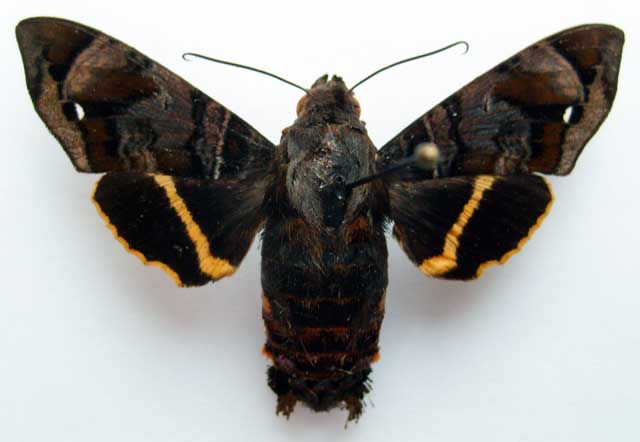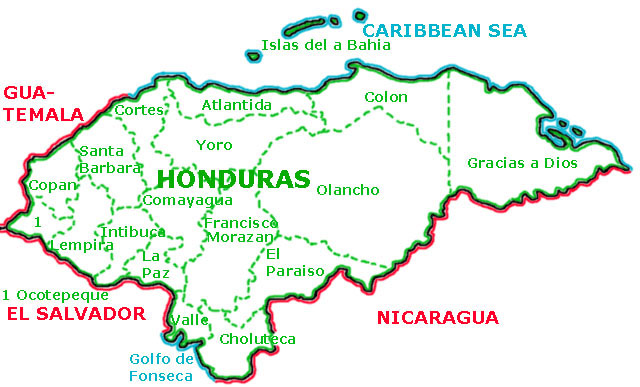|
|
Updated as per Catalogo de las Especies de Sphingidae en Honduras, Ana Clariza Samayoa and Ronald D. Cave,
January 17, 2008
Updated as per personal communication with Robert Lehman; December 17, 2011
|
Sphingidae
of Honduras: Atlantida

Eupyrrhoglossum sagra male, 5 km west of La Ceiba, Atlantida, Honduras,
October 28, 2009, courtesy of Robert Lehman.

Honduras has three distinct topographical regions:
an extensive interior highland area and two narrow coastal lowlands.
The interior, which constitutes approximately 80 percent of the
country's terrain, is mountainous. The larger Caribbean lowlands in
the north and the Pacific lowlands bordering the Golfo de Fonseca are
characterized by alluvial plains.
Interior Highlands:
The interior highlands are the most prominent feature of Honduran
topography. Composing approximately 80 percent of the country's total
area, these mountain areas are home to the majority of the
population. Because the rugged terrain has made the land difficult to
traverse and equally difficult to cultivate, this area has not been
highly developed. The soil here is poor; Honduras lacks the rich
volcanic ash found in other Central American countries. Until the
early part of the twentieth century, the highlands economy consisted
primarily of mining and livestock.
In the west, Honduras's mountains blend into the mountain ranges of
Guatemala. The western mountains have the highest peaks, with the
Pico Congolón at an elevation of 2,500 meters and the Cerro de Las
Minas at 2,850 meters. These mountains are woodland covered with
mainly pine forests.
In the east, the mountains merge with those in Nicaragua. Although
generally not as high as the mountains near the Guatemalan border,
the eastern ranges possess some high peaks, such as the Montaña de la
Flor at 2,300 meters, El Boquerón (Monte El Boquerón) at 2,485
meters, and Pico Bonito at 2,435 meters.
One of the most prominent features of the interior highlands is a
depression that runs from the Caribbean Sea to the Golfo de Fonseca.
This depression splits the country's cordilleras into eastern and
western parts and provides a relatively easy transportation route
across the isthmus. Widest at its northern end near San Pedro Sula,
the depression narrows as it follows the upper course of the Río
Humuya. Passing first through Comayagua and then through narrow
passes south of the city, the depression widens again as it runs
along the border of El Salvador into the Golfo de Fonseca.
Scattered throughout the interior highlands are numerous flatfloored
valleys, 300 to 900 meters in elevation, which vary in size. The
floors of the large valleys provide sufficient grass, shrubs, and
dry woodland to support livestock and, in some cases, commercial
agriculture. Subsistence agriculture has been relegated to the slopes
of the valleys, with the limitations of small-sized holdings,
primitive technology, and low productivity that traditionally
accompany hillside cultivation. Villages and towns, including the
capital, Tegucigalpa, are tucked in the larger valleys.
Vegetation in the interior highlands is varied. Much of the western,
southern, and central mountains are open woodland-- supporting pine
forest interspersed with some oak, scrub, and grassy clearings. The
ranges toward the east are primarily continuous areas of dense,
broad-leaf evergreen forest. Around the highest peaks, remnants of
dense rain forest that formerly covered much of the area are still
found.
The list on this page has been generated from information provided
to me by Robert Lehman (RL) of La Ceiba, Honduras, and from the
Catalogo de las Especies de Sphingidae en Honduras, prepared by
Ana Clariza Samayoa and Ronald D. Cave (SC).
I question the inclusion of Manduca vestalis by (SC) as I
feel that species is limited to South America.
I have included seven additional "speculative" (i.e. unconfirmed) (WO ?)
species based on general range descriptions without specific comment
regarding Atlantida, or even Honduras for that matter. They may
or may not be present.
Use your browser "Back" button to return to the previous page.
This page is brought to you by
Bill Oehlke and the
WLSS. Pages are on space rented from Bizland. If you would like
to become a "Patron of the Sphingidae Site", contact Bill.
Please send sightings/images to Bill. I will do my best to respond to
requests for identification help.

